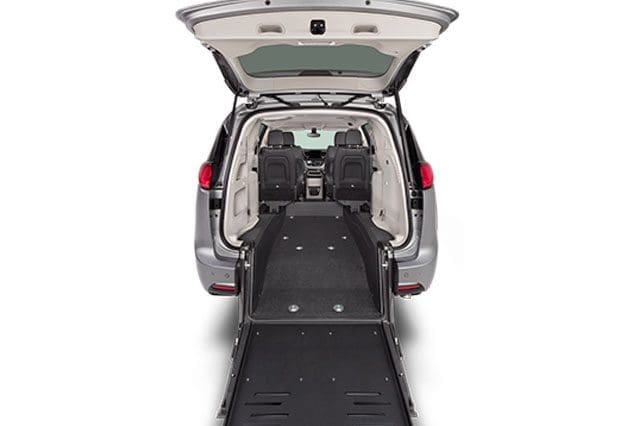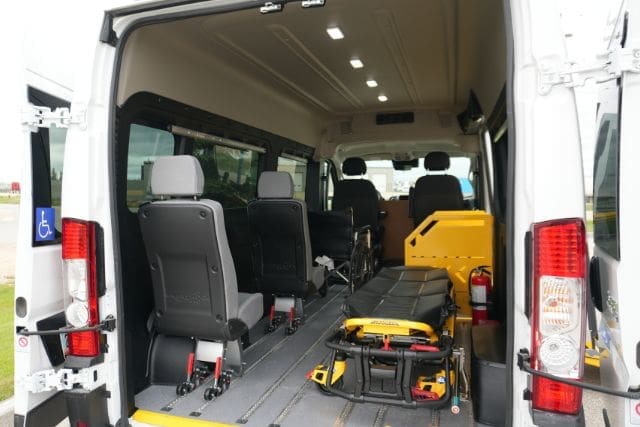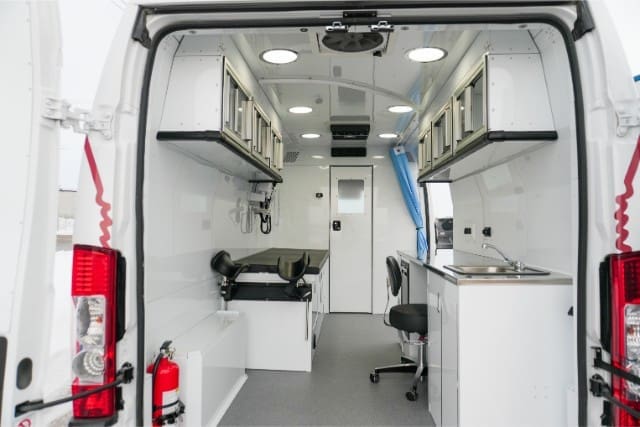Are you considering rear entry accessible minivans for your organization, program, or family? There are two types of rear entry minivans you need to consider: long cut and short cut.
The difference between them may seem small, but it can impact the number of passengers you can take, the ease of use for your drivers, and the comfortability of your passengers.
If you choose the wrong option, your passengers may experience feelings of loneliness and disorientation (more on this later).
So, it’s very important that you know and understand the ins and outs of both options, so that you can make a decision that you, your drivers, and (most importantly) your passengers are happy with.
In this article, you will learn the pros and cons of each option and who each option is generally right for.
First, let’s establish what we mean by “long cut” and “short cut.”
Long cut vs. short cut accessible minivans: what’s the difference?
There is one major difference between a long cut and a short cut minivan, and that’s, well, the van floor. Take a peek at the photo below:

As you can see, there is a channel inside the van floor. This is because the floor has actually been lowered to create enough headroom (the distance between the wheelchair user’s head and the roof of the van).
When we talk about “long cut” and “short cut” minivans, we’re talking about the length of that channel in the floor.
Now that you know what, exactly, we’re talking about, you’re probably wondering what the differences are between a long cut and a short cut minivan.
Long cut accessible minivans
A long cut conversion extends the lowered section of floor further into the van, right up behind the front driver and passenger seats. A long cut wheelchair van can accommodate 2 standard size wheelchairs, or 1 longer wheelchair.
Short cut accessible minivans

A short cut conversion limits the length of the lowered floor section to the back of the van, in the area behind the second row of seats. A short cut typically only fits 1 standard size wheelchair.
Now that you understand what the major differences are between a long cut and a short cut minivan, you may be wondering what the pros and cons are of each vehicle.
Pros of long cut accessible minivans
More flexibility
A long cut minivan offers more flexibility in terms of how many wheelchairs it can transport. It can transport two standard-sized wheelchairs or one bigger wheelchair.
This is important to consider if you are an organization, such as an adult daycare, that needs to transport more than one wheelchair user at a time.
Driver and wheelchair passengers can be much closer
While this may not seem like such an important pro at first, it is.
Imagine you are a wheelchair user, and every time you are going on an outing, you’re secured into the very back of the van (as it is with a short cut minivan). The driver struggles to hear you, so you find there’s no point in trying to talk. It’s lonely.
On the other hand, in a long cut minivan you can be secured right behind the driver. Conversation is easy because you are a part of it. You are not lonely.
Better visibility for the wheelchair user
In a long cut minivan, the wheelchair user can easily see out of the front window because there is usually no bench blocking it from view.
Again, while this may not seem important at first, take a moment to think about it. When you’re in a moving vehicle and you can’t see exactly where you’re going, it can become disorienting.
It’s very important to consider the comfort of the wheelchair user when buying a wheelchair van.
Now that we’ve covered the pros of a long cut minivan, you’re likely wondering what the cons are. Read on to find out.
Cons of long cut accessible minivans
Typically, the price is higher as it’s a more extensive conversion
Remember when we talked about how, in long cut and short cut minivans, the van floor has actually been lowered?
Well, because a long cut minivan has a longer cut in the floor, and hence a more extensive conversion, it typically costs more.
Usually, a second-row bench is not possible (but you still have 2 second row seats)
With a longer cut in the floor, there isn’t room for a second bench in the minivan, although they typically come with 2 “flip and fold” seats in the second row. This means you can usually fold them up to the side of the van to fit 2 wheelchairs when the seats aren’t being used.
The lack of a second bench is an important factor to consider for organizations that will be transporting more than 1 passenger at a time. Think about your needs: are you an adult daycare transporting 1 wheelchair user and more than 2 other passengers? Then you may need that second bench.
Now that we’ve covered the pros and cons of a long cut minivan, let’s talk about short cut minivans.
Pros of short cut accessible minivans
Can be used as a usual minivan but with wheelchair capability
This means your wheelchair accessible minivan will feel like a standard minivan–and have similar capacity to a standard minivan–but you will still be able to safely transport 1 wheelchair.
This is typically a pro for families who have a member of their family that uses a wheelchair, such as a child. You’re still able to transport nearly as many passengers as you would normally.
If wheelchair access is a mandate, but is rarely used, this is a good lower cost option
This is usually only a pro for commercially-used short cut minivans, such as taxis, because a short cut conversion is generally less expensive than a long cut conversion.
However, we typically only recommend a short cut minivan for commercial use if it will be rarely used, for reasons you’ll learn next.
Cons of short cut accessible minivans
The wheelchair passenger often feels isolated at the back of the van
We did talk about this earlier, but here’s a recap in case you forgot:
Imagine you are a wheelchair user, and every time you are going on an outing, you’re secured into the very back of the van.
Again, how the wheelchair user feels while using the van is very important because we want to encourage inclusivity and pay attention to the humanity of those riding with us.
It can be hard to see out the front of the van with the second row bench in the way
With a second row in front of the wheelchair user, visibility goes out the window–or, wait, there is no window for it to go out of because you can’t see it.
Again, while this may not seem important at first, take a moment to think about it. When you’re in a moving vehicle and you can’t see exactly where you’re going, it can become disorienting–that’s why visibility is so important, not only for drivers, but also for passengers.
Unless you have electronic restraints, securing a wheelchair in a short cut van can be difficult for staff
In a short cut minivan, the front restraints are directly behind the second-row bench. To use them, drivers have to slide the bench seats forward and bend down to access the front restraints. Most drivers find this very difficult.
The ride quality is not as comfortable
The back of a van is loud–and louder still when there is a ramp installed in it. When a wheelchair user is secured in the back of a short cut minivan, they can feel the bumps and turns more than they would in a long cut minivan, and they can hear them more too.
So, a short cut minivan is overall less of an enjoyable ride than a long cut minivan.
Check out this table below for a review of all the information we just talked about:
| Long cut accessible minivans | Short cut accessible minivans | |
| Capacity | 2 standard sized wheelchairs or 1 long wheelchair | 1 standard sized wheelchair |
| Distance between driver and wheelchair user | Close | Far |
| Visibility for wheelchair user | Good | Poor |
| Cost | More | Can be less |
| Second row availability | No (but 2 seats are available) | Yes |
| Rider comfortability | Good | Can be poor |
Long cut vs. short cut rear entry minivans: who is each option right for?
Check out both of these checklists to help determine if a long cut or short cut minivan is right for you.
Long cut accessible minivans are right for you if:
- You need to transport more than 1 wheelchair
- You need to transport a larger wheelchair
- Having the wheelchair user closer to the driver is important to you
- You don’t require a second row inside the van
Short cut accessible minivans are right for you if:
- You only need to transport 1 standard sized wheelchair
- You don’t mind having the wheelchair far away from the driver
- You have a smaller budget
- You need a second row inside the van
Your next steps to choosing between long cut vs. short cut accessible minivans
You came to this article to learn if a long cut or short cut minivan is right for you.
Now, you know the pros and cons of both and, generally, who each option is right for.
If you’re still not sure which option is right for you, talk to a MoveMobility expert today.
Or, check out these related articles for more information:








